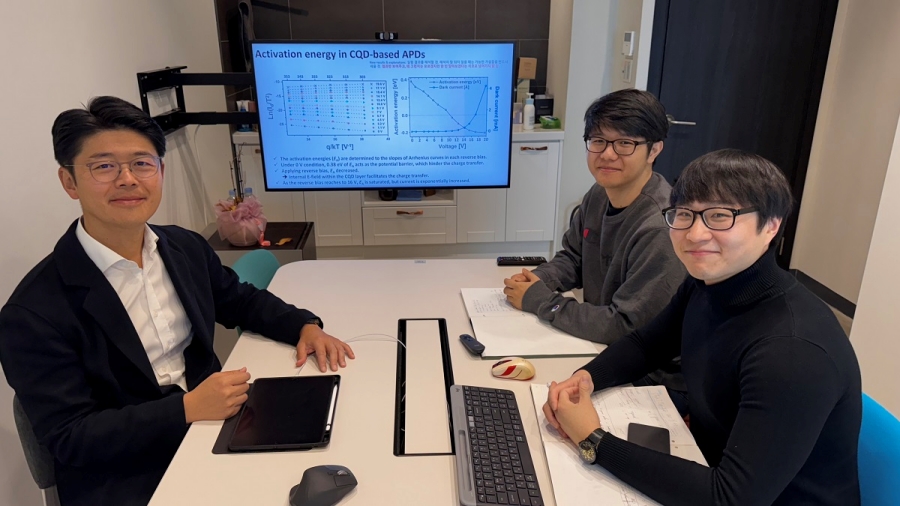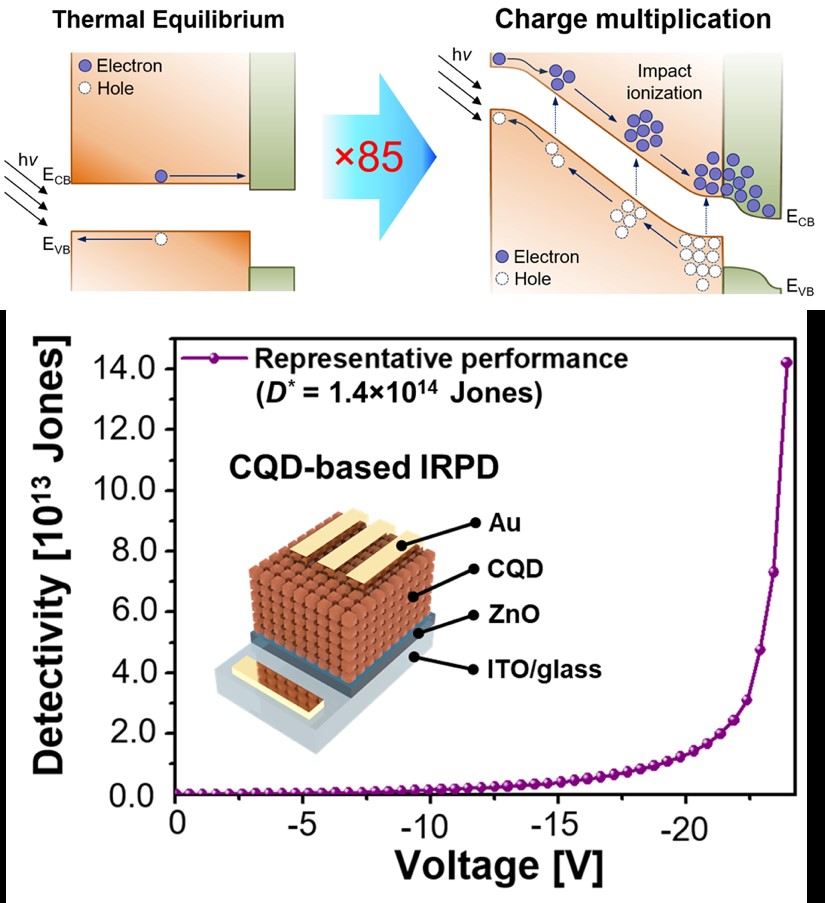
<(From left) Professor Jung-Yong Lee, Ph.D. candidate Yun Hoo Kim and Dr. Byeongsu Kim>
In a significant breakthrough for quantum technology, KAIST researchers have developed an advanced avalanche multiplication technology using colloidal quantum dots (CQDs). This innovation addresses key limitations in avalanche photodiode (APD) devices, which are crucial for applications such as quantum computing, night vision, autonomous vehicles, and space observation. *Avalanche Photodiode Devices: APD devices using crystalline semiconductors have long been employed to detect extremely faint light. However, these conventional devices suffer from high thermal noise, requiring cryogenic cooling, and lack materials with high detection efficiency in the infrared spectrum. These challenges have restricted their practicality for quantum communication and infrared sensing applications.
EE research team led by Professor Jung-Yong Lee has successfully developed an avalanche charge multiplication technology utilizing colloidal quantum dots (CQDs). This technology achieves 85-fold electron generation from a single infrared photon absorption, surpassing the limitations of conventional techniques. *Avalanche Charge Multiplication: A signal amplification method where electrons in a semiconductor, subjected to a strong electric field, gain kinetic energy and collide with adjacent atoms, generating additional electrons.
Colloidal quantum dots (CQDs), chemically synthesized semiconductor nanoparticles, are emerging as promising candidates for next-generation infrared sensors due to their solution processability and facile bandgap tunability. Unlike traditional crystalline semiconductors, CQDs possess a unique energy structure that effectively suppresses thermal noise. However, their low charge mobility and high charge recombination rates due to surface bonds often degrade charge extraction efficiency.
The research team addressed these challenges by applying a strong electric field to accelerate electrons, gaining kinetic energy and generating additional electrons through a cascading process in neighboring quantum dots. This led to an 85-fold signal amplification under infrared irradiation at room temperature and the developed CQD-based photodetector achieved a specific detectivity of over 1.4×10¹⁴ Jones, surpassing the sensitivity of standard night vision devices by tens of thousands of times.

<Figure 1. Schematic illustration of avalanche charge amplification mechanisms
in quantum dot devices and the specific detectivity performance of the quantum dot-based avalanche photodiode.>
Infrared photodetectors are essential for a wide range of applications, including autonomous vehicles, quantum computing, and advanced medical imaging. However, traditional quantum dot-based technologies have long been limited by low sensitivity and high noise.
This research represents a paradigm-shifting technological advance, establishing a strong foundation for South Korea to lead the global quantum technology market by securing core innovations in quantum sensing and infrared detection.
Dr. Byeongsu Kim, the first author of the study, emphasized the groundbreaking nature of this work: “The quantum dot avalanche device is an entirely novel research area, never previously reported. This foundational technology has the potential to drive ventures that will lead the global markets in autonomous vehicles, quantum computing, and medical imaging.”
Dr. Byeongsu Kim from KAIST’s Information and Electronics Research Institute, Dr. Sang Yeon Lee from IMEC, and Dr. Hyunseok Ko from the Korea Institute of Ceramic Engineering and Technology contributed as co-first authors of the study. Their findings was published in Nature Nanotechnology on December 18, under the title: “Ultrahigh-gain colloidal quantum dot infrared avalanche photodetectors” (DOI: 10.1038/s41565-024-01831-x).
This research was supported by the National Research Foundation of Korea, including Nano-Material Technology Development Program, Strategic Research Laboratory Program for Future Displays, and Individual Basic Research Program.